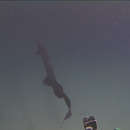Diagnostic Description
provided by Fishbase
Eel-like shark with 6 gill slits, the lower ends of the first gill slits connected t each other across throat (Ref. 247). Dark brown or grey in color, sometimes paler below (Ref. 26346). Dorsal fin small and lobe-like originating over pelvic fin bases to behind anal fin origin (Ref. 6871). Anal fin larger than dorsal fin (Ref. 6871). Pectoral fins small and paddle-shaped (Ref. 6871). Caudal fin with weak ventral lobe and without subterminal notch (Ref. 6871). Terminal mouth with tricuspid teeth in both jaws (Ref. 247).
- Recorder
- Cristina V. Garilao
Life Cycle
provided by Fishbase
Ovoviviparous, embryos feed solely on yolk (Ref. 50449). Number of young 2 to 15 (Ref. 26346). Gestation period is probably very long, one to two years (Ref. 39551). Size at birth 40-60 cm (Ref. 6871). Distinct pairing with embrace (Ref. 205).
Morphology
provided by Fishbase
Dorsal spines (total): 0; Dorsal soft rays (total): 0; Analspines: 0; Analsoft rays: 0; Vertebrae: 146 - 171
- Recorder
- Cristina V. Garilao
Trophic Strategy
provided by Fishbase
An uncommon primitive shark (Ref. 26346) found on outer continental and insular shelves and upper slopes, usually between 120 and 1,280 m but occasionally caught at the surface (Ref. 247). Feeds on other sharks, squid and bony fish (Ref. 26346).
Biology
provided by Fishbase
An uncommon primitive shark (Ref. 26346) found on outer continental and insular shelves and upper slopes, usually between 120 and 1,280 m but occasionally caught at the surface (Ref. 247). Feeds on other sharks, squid and bony fish (Ref. 26346). Ovoviviparous (Ref. 50449), litter size ranges from 2 to 10 (Ref. 37390). Not dangerous but teeth are sharp enough to inflict lacerations on the hands of the unwary scientist examining its mouth (Ref. 247). Incidental in bottom trawl catches and utilized as fishmeal and as food fish (Ref. 247).
- Recorder
- Kent E. Carpenter
Importance
provided by Fishbase
fisheries: minor commercial; price category: unknown; price reliability:
- Recorder
- Kent E. Carpenter

